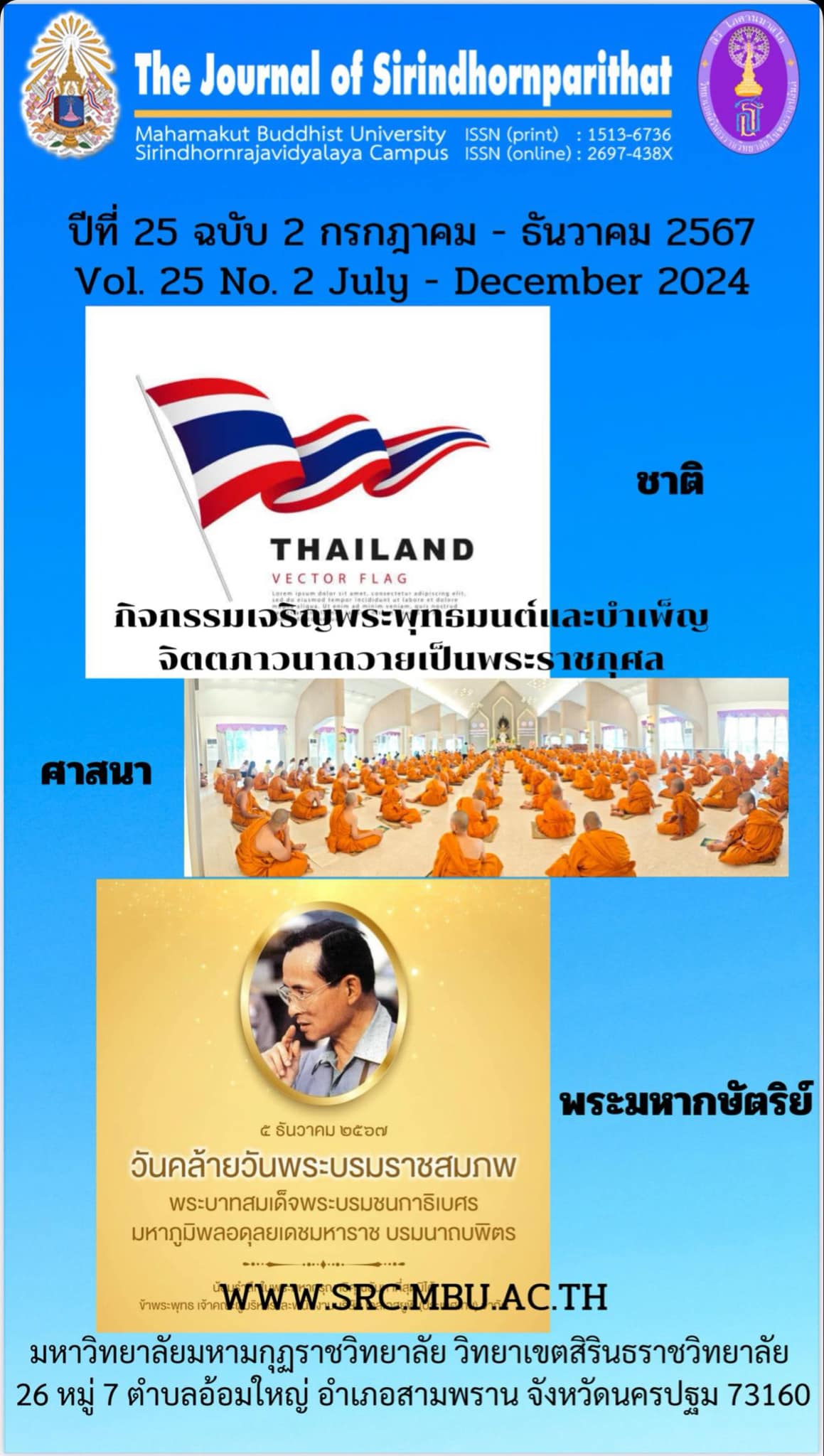The Effects of Using Model-Based Instruction in the Topic of the Earth and Natural Resources to Develop Critical Thinking and Learning Achievements of Grade 8 Students at Danmakhamtiawittayakhom School in Kanchanaburi Province
Keywords:
Model-based Learning, Critical Thinking, Academic AchievementAbstract
The objectives of this research were to (1) compare critical thinking between before learning and after learning using model-based instruction. of grade 8 students in the topic of the earth and natural resources (2) compare learning achievements in the topic of the earth and natural resources of grade 8 students after learning using model-based instruction compared to the 70 percent criteria and (3) study the relationship between critical thinking and learning achievement of grade 8 students in the topic of the earth and natural resources after learning using model-based instruction.
The sample used in this research was 39 grade 8 students, semester 2, academic year 2023, Danmakhamtiawitthayakhom school, Kanchanaburi province, obtained by cluster random sampling. The research tools were 8 learning plans using model-based in instruction on the topic of earth and natural resources, totaling 24 hours, a critical thinking assessment form with a reliability value of 0.83 and a science achievement test with a reliability value of 0.84. Statistics used for data analysis included percentage, mean, standard deviation, t-test and correlation.
The results of the research found that
- the of grade 8 students after learning by using model-based critical thinking instruction was significantly higher than before learning at the .05 level
- Science learning achievement of grade 8 students after learning by using instruction was higher than the 70% criterion with at the .05 level significance of statistical and
- critical thinking ability and learning achievement of grade 8 students after learning by using model-based instruction was moderate relationship statistically significant at the .05 level.
References
กระทรวงศึกษาธิการ. (2551). หลักสูตรการศึกษาขั้นพื้นฐาน พุทธศักราช 2551. กรุงเทพฯ: โรงพิมพ์คุรุสภาลาดพร้าว.
เกรียงศักดิ์ เจริญวงศ์ศักดิ์. (2541). กระบวนทัศน์วัฒนธรรมไทย ต้นตอ เศรษฐกิจถดถอย. วารสารสังคมศาสตร์ปริทัศน์ 19 (2) (มกราคม-มิถุนายน) :10
จุฑามาศ กันทะวัง. (2563). การจัดการเรียนรู้โดยใช้แบบจำลองเป็นฐานวิชาชีววิทยา เพื่อพัฒนาผลสัมฤทธิ์ทางการเรียนและการให้เหตุผลเชิงวิทยาศาสตร์ ของนักเรียนชั้นมัธยมศึกษาปีที่ 4.
จุลลดา ทำประเสริฐ. (2561). การพัฒนาผลสัมฤทธิ์ทางการเรียน. เรื่อง หน่วยของสิ่งมีชีวิตระดับชั้นมัธยมศึกษาปีที่ 1 โดยใช้วัฏจักรการสืบเสาะหาความรู้ 5 ขั้น ร่วมกับกิจกรรมการเรียนรู้โดยใช้แบบจำลองเป็นฐาน. วิทยานิพนธ์, มหาวิทยาลัยอุบลราชธานี. วิทยานิพนธ์ปริญญามหาบัณฑิต สาขาการสอนวิทยาศาสตร์ คณะศึกษาศาสตร์ มหาวิทยาลัยบูรพา.
ชาตรี ฝ่ายคำตา และภรทิพย์ สุภัทรชัยวงศ์. (2557). การจัดการเรียนรู้โดยใช้แบบจำลองเป็นฐาน Model-Based Learning. วารสารศึกษาศาสตร์ปริทัศน์, 29(3), 86-99.
ชูศรี วงศ์รัตนะ. (2541). เทคนิคการใช้สถิติเพื่อการวิจัย. พิมพ์ครั้งที่ 7. กรุงเทพฯ: เทพเนรมิตการพิมพ์.
ธนพล ถัดทะพงษ์. (2560) การพัฒนากิจกรรมการเรียนรู้วิชาเคมี แบบเน้นงานปฏิบัติ เพื่อส่งเสริมการคิดอย่างมีวิจารณญาณ เรื่องสารชีวโมเลกุล สำหรับนักเรียนชั้นมัธยมศึกษาปีที่ 6. การค้นคว้าอิสระ, มหาวิทยาลัยนเรศวร.
ธีระภัทร พินิจมนตรี. (2561). การจัดการเรียนรู้โดยใช้แบบจำลองเป็นฐานเพื่อส่งเสริมการคิดอย่างมี วิจารณญาณและผลสัมฤทธิ์ทางการเรียน เรื่อง โลกและการเปลี่ยนแปลงสำหรับนักเรียนชั้นมัธยมศึกษาปีที่ 2.วิทยานิพนธ์ ,มหาวิทยาลัยราชภัฏมหาสารคาม.
วรรณทิพา รอดแรงค้า. 2541. ทฤษฎีการสร้างความรู้ (Constructivism). สสวท 26 (101) : 7-12.
วิชัย วงษ์ใหญ่. (2542). พลังเรียนรู้ในกระบวนทัศน์ใหม่. กรุงเทพฯ : คณะศึกษาศาสตร์ มหาวิทยาลัยศรีนครินทรวิโรฒ.
สถาบันส่งเสริมการสอนวิทยาศาสตร์และเทคโนโลยี. (2546). การจัดสาระการเรียนรู้กลุ่มวิทยาศาสตร์หลักสูตรการศึกษาขั้นพื้นฐาน. กรุงทพฯ: สถาบันส่งเสริมการสอนวิทยาศาสตร์และเทคโนโลยี.
สุคนธ์ สินธพานนท์.(2552). นวัตกรรมการเรียนการสอนเพื่อพัฒนาคุณภาพของเยาวชน. พิมพ์ครั้งที่ 3.กรุงเทพฯ: เทคนิคพริ้นติ้ง.
Downloads
Published
Issue
Section
License
Copyright (c) 2024 Mahamakut Buddhist University

This work is licensed under a Creative Commons Attribution-NonCommercial-NoDerivatives 4.0 International License.
บทความที่ได้รับการตีพิมพ์เป็นลิขสิทธิ์ของ มหาวิทยาลัยมหามกุฏราชวิทยาลัย วิทยาเขตสิรินธรราชวิทยาลัย
ข้อความที่ปรากฏในบทความแต่ละเรื่องในวารสารวิชาการเล่มนี้เป็นความคิดเห็นส่วนตัวของผู้เขียนแต่ละท่านไม่เกี่ยวข้องกับหาวิทยาลัยมหามกุฏราชวิทยาลัย วิทยาเขตสิรินธรราชวิทยาลัย และคณาจารย์ท่านอื่นๆในมหาวิทยาลัยฯ แต่อย่างใด ความรับผิดชอบองค์ประกอบทั้งหมดของบทความแต่ละเรื่องเป็นของผู้เขียนแต่ละท่าน หากมีความผิดพลาดใดๆ ผู้เขียนแต่ละท่านจะรับผิดชอบบทความของตนเองแต่ผู้เดียว




